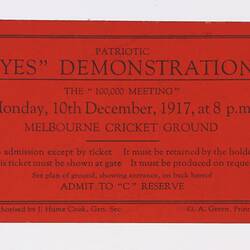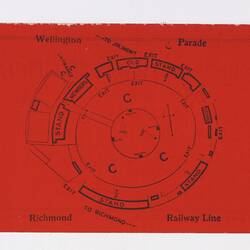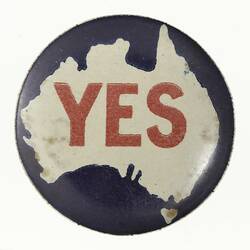Summary
'C' reserve ticket for a pro conscription demonstration held at the Melbourne Cricket Ground (MCG) on Monday 10 December 1917 at 8 pm. Authorised by James Hume Cook, Federation and General Secretary, the ticket was printed by G.A. Green.
The Brisbane Courier described the demonstration the next day in glowing terms:
'The largest conscription meeting ever held in Australia and the biggest held in any place in the Commonwealth, took place at the Melbourne Cricket Ground to-night. It was arranged by the Reinforcements Referendum Council, and war known as the 100,000 meeting, but even the most optimistic of the promoters could have hardly expected such a tremendous gathering. There were well over 100,000 persons present. Two hours before the meeting began there must have been 40,000 people in the stands and in the arena, and the attendance rapidly increased, until the 100,000 mark was passed. An elaborate programme had been arranged for, in addition to the speeches. There were several bands and choirs, and cinematograph pictures, giving details in concise form of the Government's proposals and reasons why they should be supported, and also statements of the world's leading me. The demonstration was marred to a certain extent by a comparatively small, but very noisy and rowdy section, who threw stones and green peaches at the Prime Minister (Mr. Hughes). Beside Mr. Hughes, the speakers included the Premier of New South Wales (Mr. Holman), the Lord Mayor of Melbourne (Councillor Stapley), Sir Alex Peacock, and several members of the Federal Parliament. Four platforms were erected in the arena, and addresses were delivered by Mr. Hughes and two or three other speakers at each platform.' (11 December 1917).
In 1916 the Australian Government, under Prime Minister Hughes, called for conscription of Australian men as voluntary recruiting did not seem to be producing sufficient numbers to supply the front line. Popular votes were held in 1916 and 1917 on the issue of conscription, which caused great divisions in Australian society and the Australian government. Both votes were defeated and conscription did not occur.
Physical Description
Red coloured card printed with black text on the obverse and a map of the MCG on the reverse.
Significance
Conscription was in fact legislated under the Australian Defence Act, but for service in Australia only. Changing the act to include overseas service did not require a public vote, however the government didn't have the numbers in the Senate, so Prime Minister Billy Hughes decided to put the issue to the Australian public. The vote was held on 28 October 1916, and narrowly defeated (51% to 49%).
A second vote was held on 20 December 1917. This time the Prime Minister had a majority in both houses, but wanted to give the people a chance to voice their opinion on the issue again. Conscription for overseas service was again defeated by a slightly greater margin.
The closeness of the first vote indicates how torn the country was over the issue. Both sides campaigned vigorously, producing badges for their respective supporters, running advertising campaigns in local and national presses, and holding public rallies.
More Information
-
Collecting Areas
-
Acquisition Information
Purchase
-
Authorised By
-
Printer
-
Inscriptions
Printed on obverse: PATRIOTIC 'YES' DEMONSTRATION/ THE "100,000 MEETING"/ Monday, 10th December, 1917, at 8 p.m./ MELBOURNE CRICKET GROUND/ No admission except by ticket It must be retained by the holder/ This ticket must be shown at gate It must be produced on request/ See plan of ground, showing entrance, on back hereof/ ADMIT TO "C" RESERVE/ Authorised by J. Hume Cook, Gen. Sec. G.A. Green, Printer
-
Classification
-
Category
-
Discipline
-
Type of item
-
Overall Dimensions
106 mm (Width), 62 mm (Height)
-
References
THE REFERENDUM. MAGNIFICENT DEMONSTRATION. (1917, December 11). The Brisbane Courier (Qld. : 1864 - 1933), p. 7. Retrieved June 13, 2014, from [Link 1]
-
Keywords
Conscription, Political Rallies, Tickets, World War I, 1914-1918



